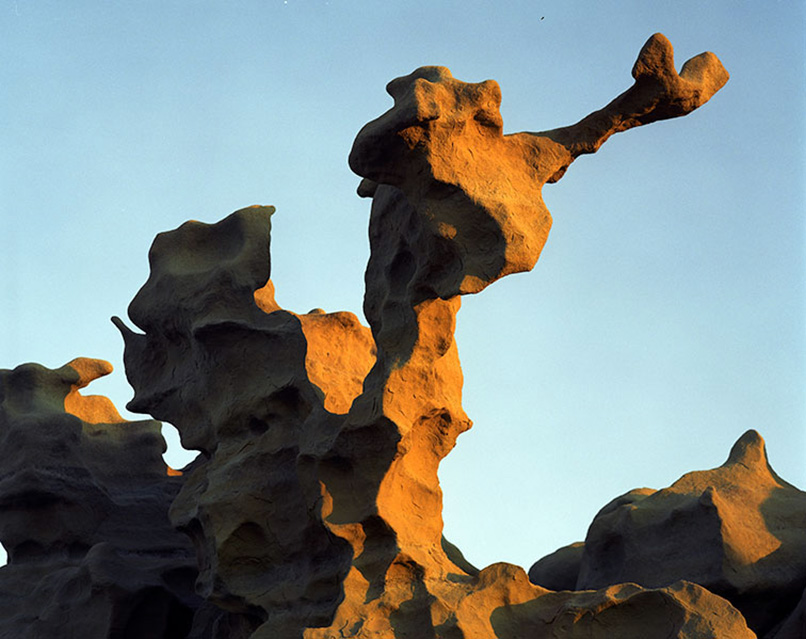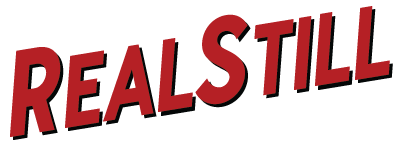
Factory Butte, Caineville Badlands, Utah (2000)
The formation was shot at 3:00 a.m. on PHR 25 film, using simple moonlight, in a one hour long exposure, to provide illumination. During these long exposures, the light source moves as the earth, moon and sun spin and orbit, the bounced sunlight off the moon is in constant “slow” movement, and is not like the instantaneous capture of land at noon, when movement is frozen. It’s film, not digital, where moonlight capture is easy and quick, and with film there is reciprocity.
In 1980 the Institute for Psychogeographic Research was founded, and, with the arrival of the internet, a format was finallly created that could handle the Institute’s long, dense accumulation of material. Psychogeography lives on now. Technically its moment of realization had been lost, but is now found here, with the internet, and perfect for a photographer who is really a filmmaker.
RealStill, and its focus is, realization. RealStill isn’t the life of the mind, and certainly is not within four walls, the ceiling and the floor. It’s not like something, but is something and its “performance” or operation is entirely in real time and place, the operator is connected as solidly as the image captured is connected to what is represented. Ideas, or anything related to the pictures and the experience are produced post-facto. The starting point is always there in fact, open and free.
My realism, call it social, critical, caustic, sarcastic or aesthetic, is lived, ask anybody.
What’s better than art, including my work? Life, its experience and the world. I can name many others, including ice cream…
The pictures aren’t real, except as objects themselves, that embody what is, in fact and deed, real – the material itself, and the work to capture it. After all the actions that take place in the actual world are over, what’s left, is an object from what could be a multi-year struggle or an immediate gift of timing. All knowledge is after the fact. Sensed first, artifact, ideas and discourse later.
RealStill is the aesthetics of experience, and that’s its difference. I don’t claim the pictures are real, only what it took to get them both on and off the field. For some reason, actual truth, and its capture, which, by its nature is an uncomfortable life, gives me pleasure, that motivates more capture and overcomes the, uh, discomfort that comes with the territory. By thruth, i mean, the thing, at a minimum.
Some sites are incomparable, some experiences of these sites, likewise. Photography, it could be landscape or street photography, captures an original and passing moment by intent, and it’s distinct as a lost moment. It could be ordinary or it could be extraordinary. And the fact that it’s never rehearsed, always random, means every act is new in potential, and has an equal chance to be a fabulous failure, a big zero or an actual capture and overall the greatest potential for witnessing novelty.
Better than art, media and entertainment? In the sense it’s outside of four walls and one ego, and inside the outside world, utilizing only the five senses through actual contact. The camera allows that and is the ideal instrument for a source artist, who, when they return from the “field” find that they really never left it. Truth of something is only verified by forcing thought to prove, by experience, its worth. Experience, contact, what’s better for truth or health? What’s better than life? Not art, not for me, and, if art, it’s better in the world, where the world and its cities is simply a museum of wonder on to itself.
And it’s cinematic as hell, inborn to the work. Is that because i was a nutural born filmmaker, with 15 years of every day hard-core film work? And did that evaporate because my patience ran low on ethical absurdities? But fortifying the work to incrdedible levels.
Better than art? If you no longer experience and you need an entertaining allegory to view at home, watch and listen to the movie, The Train, which successfully demonstrates answers to the question, “What’s better than art?” Like the pleasure of eating ice cream, seeing proof from experience, in a shot, makes me feel good, i guess, in the face of tasteless lies. Shying from neither sarcasm nor realism, where ever i go, they cry out. That’s because i can prove and express and make mutually inclusive, what others, for too long, simply question. In fact it’s been questioned so much, whether in art, politics or religion, that the images intended as proof are flipped as evidence that they are, in fact, not true, because it feels right.
One thinks of the Sekula aphorism, “There used to be a myth that photography told the truth, now there is a myth that photography doesn’t.”

Rodin’s, The Thinker, this one blown up and off its pedastal in 1970 and put back in place, unrestored, creating a lasting document of the polarized and rebellious Sixties and early seventies.
Every year since its inception, there are more photographs taken. We now make over 1.3 trillion in one year’s time. In art, can pictures prove while expressing? Which ones, and through what process, will certain stills live on?
If you could stop the will from being, and being in things, you could see something for what it is. That’s the flip of a group of individuals, each expressing their views on something, some of whom, these days, could be just wacked out conspiracies and misinformation.
Trying to capture is a hit and miss gamble, and, obviously, it’s the camera and sound recorder, depending on the operator, that makes it possible, by putting things in order (direction), to see and hear clearly in the same way a machine would. The operator, then, should be a master of time and place.

Fantasy Canyon, Utah, 2000. Here a camera, secure on a tripod, its lens is kept open in a perfectly still, silent, one hour long stare-down and is a form of hyper-concentration, set in an absolutely still moonlit landscape, that becomes more and more lit with time.
To see (or hear) some thing living or not, for just what it is, by stopping the will, then, that, would really be something, and, at the very least, some thing.
To immerse, through experience alone, never leaving for anything, including, ambitions, in order to produce truthful images is not the career trajectory of the professionally trained artist, since the 1980s, expecting recognition, and, the Name in their lifetime. How could the mode of RealStill mode be understood, beginning with no one cares? Going in and shooting for years, sometimes to a single location, not even making a print, but impressed upon the shooter, understanding by experiencing it over time, not the hit and run, that, i think, that photography was built to do. But it could be used to dig deeper and return always, no forgetting, becuase it’s in you
I have no “influences” and never spend any time in any art world. My way of doing develops both BDNF from fasting and physical activity, used to find the right form for the subject and how it’s captured, instead of the readily available existing forms that you would use to construct and frame your work, if, you were institutionalized, academic, or, live entirly in climate controlled cubicles. In the chaos of pure reality, for instance, in the industrial landscape, it’s only intuition, physical ability, aim, balance and drive, in combination that get’s the shot done, and allows me to return home safe with limited injuries.
Between 1995 and 2006, on a Jersey Run, shooting the infrastructure of the Meadowlands, i was holed up in the west portals of the Hoboken tubes and tunnels that drill through the Heights of Jersey City. In 1999, they were making a movie on the roof of a Jersey City apartment building that towered above the tunnel and cut system that i was shooting.
Authentic culture is only lived, it’s mode of operation can only be taught by example, and, at a blood price. That should be its value, since the aim is truer here. Sometime it might take the skills of action, and, just plain soldiering most of the time to capture something better than art. That would be living.
